Plastic injection molding has a language all its own, and with hundreds of unique terms, it can be difficult to learn the language. To help, we put together a list of the 15 more commonly used terms to know when discussing plastic injection molding, mold parts, machinery, materials, and problems. We hope you find this to be a useful resource.
Injection Molding Terms:
Resin
Resin is the raw material used to create the finished part in the plastic injection molding process. With hundreds of commodity and engineering resins available on today’s market, the material selection process for plastic injection molding may seem daunting at first, so research your options carefully, and consult with an experienced plastic injection molder to help determine the ideal choice.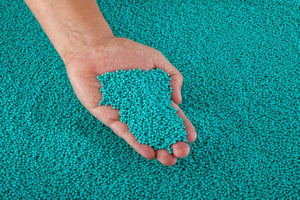
Colorant
A pigment system, usually in pelletized form, or liquid, which is mixed with resin to produce the desired color. To pinpoint the desired color for each plastic product or part, a color matching process must be completed, which allows engineers to develop a specific color concentrate for a particular application. Typically, a chip, plaque, or Pantone number provides an approximate idea of the desired hue, and information about the specific polymer being used helps to determine the formulation for the color concentrate.
Mold
A hollow form often made from stainless steel that plastic is injected or inserted into to manufacture a plastic part. Molds can be expensive to design and manufacture because of this they are typically only used in mass production. As one of the most significant production investments, it is critical that the molds are made with a great deal of accuracy. Tight-tolerance, precision molds that are made from the best steel available should last for years to come.
Mold Cavity
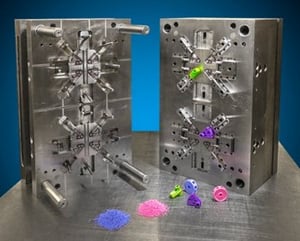 The hole in the mold that is in the shape of the desired part, this is where the plastic resin is injected into to make the part. Fewer cavities in a mold require less tooling work, time and ultimately less cost. A reputable, experienced molder will be able to maximize cavitation in the mold to maintain the highest level of productivity. In general, most molders recommend creating one mold per part versus creating a family mold. Family molds are created with various cavities for different parts. They tend to produce inferior products and have more downtime due to maintenance issues.
The hole in the mold that is in the shape of the desired part, this is where the plastic resin is injected into to make the part. Fewer cavities in a mold require less tooling work, time and ultimately less cost. A reputable, experienced molder will be able to maximize cavitation in the mold to maintain the highest level of productivity. In general, most molders recommend creating one mold per part versus creating a family mold. Family molds are created with various cavities for different parts. They tend to produce inferior products and have more downtime due to maintenance issues.
Wall Thickness
Of all the various design aspects, wall thickness has the most significant impact on the cost, production speed, and final quality of a part. Wall thicknesses are not subject to any restrictions, but generally, the goal is to create the thinnest wall possible while taking into account the part’s structural requirements and overall size and geometry. The flow behavior and material qualities of the resin should also be considered. Uniform wall thickness also allows for the most efficient, uniform flow of resin through a tool for ideal processing. Variations in wall thickness cause molten polymers to take preferential flows, leading to air trapping, unbalanced filling, and weld lines.
Flash and Burrs
Sometimes known as burrs, flash is the occurrence of thin, wafer-like protrusions on a finished part caused when melted resin escapes the mold cavity. Most common along the parting line or an ejector pin, flash can be caused by excessive injection speed or pressure, in which case the fix is a simple reduction. More often flash is due to poorly designed or severely degraded molds, in which case a redesign or retooling is required. Flash can also be caused by too high of a mold temperature and excessive barrel heat.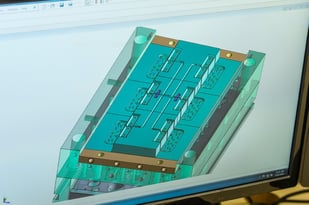
Runner System
The channel system that allows the flow of the melted material to fill the part cavities. There are two main categories: hot runner and cold runner systems. Each of these systems has its benefits and limitations which make them better suited for specific applications. Understanding the differences between these technologies can help you have a more productive and informed discussion with your plastic injection specialist to determine the most feasible option for your unique application.
Hydraulic Process
Hydraulic is the predominant type of process used in plastic injection molding. These types of machines employ hydraulic cylinders to clamp together two halves of a mold at high pressure. Plastic substrate pellets are then melted, and the liquid is injected into the mold cavity. Once the plastic has cooled and hardened, the mold halves are separated, the part is extracted, and the process is repeated. The hydraulic process uses a hydraulic press which is not as precise as electric presses.
Electric Process
All-electric presses were introduced in 1983. The newer all-electric press technology is quieter to operate, faster and have higher accuracy. These machines are powered by digitally controlled high-speed servo motors rather than hydraulics, allowing for a faster, repeatable, more precise, and energy-efficient operation. Electric machine operation is highly predictable, so once a desirable injection process has been reached, it can be replicated very consistently, resulting in higher quality parts. The machinery required for the all-electric process is more expensive than the hydraulic process. 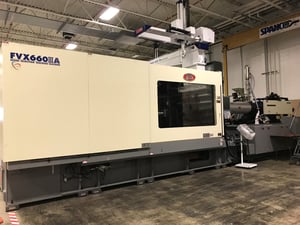
Hybrid Process
Combining the best of both worlds, hybrid injection molding machines have been on the market for a few decades now, and combine the superior clamping force of hydraulic machines with the precision, repeatability, energy savings, and reduced noise of electric machines. This allows for better performance for both thin- and thick-walled parts. These machines have become increasingly popular over the last few years due to their efficiency and ease of use.
End-of-Arm Tooling
Speed and efficiency in plastic injection molding equate to cost savings. So, it is no surprise that robots play a significant role in improving the manufacturing process. From simple sprue pickers to complex automated End-of-Arm Tooling (EOAT), the industry is taking advantage of this technology. The EOAT is often assembled along with the electronics, pneumatics, and sensors needed to meet the specific processing requirements of the job.
Tonnage
Presses are rated, or classified, based on tonnage, which indicates how much clamping pressure a particular machine can offer. Press tonnage, or force, can range from less than 5 tons to over 4,000 tons. The higher a machines tonnage is rated, the larger it is. Pressure keeps a mold closed during the injection process; too little can compromise quality and result in flashing — the appearance of excess material on the part edge. To determine the appropriate size press for your application, consider the following key variables such as material choice, size of the part and press rating. 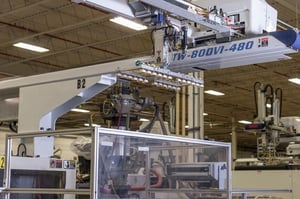
Hopper and Barrel
The hopper stores the plastic to be used in the injection molding process. For materials such as Nylon, ABS, and PET, a dryer unit may be added to dry the plastic for processing and to keep any external moisture away from the material. The hopper may also contain small magnets to prevent any harmful metallic particles from entering the machine. The plastic that is placed in the hopper is usually in some type of granular form. The plastic material is then melted using heater bands and is then injected through the nozzle into a mold cavity. The pellets are fed from the hopper to the barrel where the material is then melted in a controlled fashion and injected into the mold in the machine.









Comments